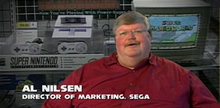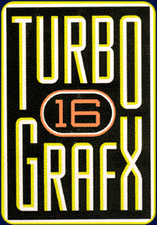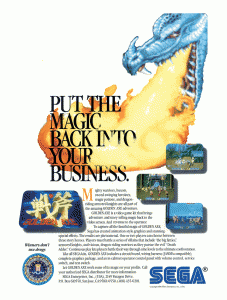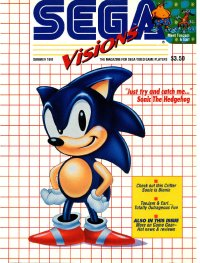If there was one thing synonymous with Sega during the Genesis era, it was the cool marketing that it used to promote its little black box. More so than any company before it, Sega took advertising to a whole new level and pushed the boundaries of what was acceptable at a time when competitors were seldom mentioned by name. Through a series of bold maneuvers and big risks, the House of Sonic went on to conquer the 16-bit market and topple a plumber’s empire.
 Since before the Genesis even launched, Al Nilsen had a front seat for every marketing battle.
Since before the Genesis even launched, Al Nilsen had a front seat for every marketing battle.
He had cut his teeth buying video games for the JC Penney stores and catalogs in the late ’70s and early ’80s, and by 1989 he found himself heading Sega of America’s marketing division. From this position, Nilsen had a hand in selecting the final name for the console, and he oversaw the implementation of some of Sega’s most memorable advertising, including the classic Genesis Does… and Sega Scream promotions. Along with Bob Harris, he also spearheaded the launch of Sega Visions magazine.
Sega-16 was fortunate enough to spend almost an hour chatting with Mr. Nilsen by phone.
Sega-16: You’ve been involved in the promotion and sales of video games since the Atari 2600 days. The console crash of 1983 shook many retailers’ confidence in gaming as a viable industry. The NES went far to restore that confidence, and by 1989 it owned the market. What major changes did you notice in the way retailers approached Sega with the Genesis? How open were they to stocking the product of Nintendo’s chief competitor?
Al Nilsen: Well, retailers were really looking for an alternative to Nintendo, because of Nintendo’s tremendous market strength. They had about 95% market share, and the Sega Master System was probably at less than 5% – Nintendo was the big monolith in the industry. They were telling the retailers what they had to do in terms of promoting their product, such as building those giant “World of Nintendo” displays, and how to advertise it. Retailers were very, very open to having a competitor that could help level the playing field. So, we really had great… hope, I guess, from the retailers that we could be a strong and viable competitor. As a result we got their support in prominently displaying, advertising and promoting Genesis. While they didn’t necessarily think that anyone could go and unseat Nintendo, or really go and give them a true run for their money, they really wanted to support us to see what would happen.
And it wasn’t just the retailers; it was also the gaming magazines and the press, who really wanted another competitor to come into the business. So it was exciting and very beneficial to have the strong support of both the retailers and the press.
Sega-16: Shortly before the Genesis was released, you were approached at a prelaunch sales meeting in California by a retailer who told you that you would be blown out by NEC’s release of the TurboGrafx-16, and that the entire unsold inventory would be returned to Sega the day after Christmas.
Al Nilsen: Even though the retailers were supportive of Sega, they had a business to run. If you remember, when we launched Genesis, the TurboGrafx-16 launched at the same time, which is a story that most people forget about. The first company that we really went and defeated in the industry was NEC with their TurboGrafx-16. They came out, and we literally shipped within a week of each another – we shipped on August 14th and they shipped on about August 20th – so there were two companies trying to go up against Nintendo, and Sega really was the underdog because NEC was this major electronics giant, and they had told the retailers that they were going to put a lot of money behind their launch.
I still vividly remember something that happened in April of ’89 as David Rhoads, Sega’s VP of Sales, and I were presenting our plans to retailers. After the presentation, we asked one major retailer if he was going to buy Genesis for his stores, and he said, “Absolutely. I’m happy to go and sell your product and promote it, but I just want you to know that on December 26th I’m going to go and return them all to you because NEC is going to eat your lunch!”
Sega-16: And they told you this at a prelaunch meeting, right when you’re trying to pitch them your new console?
Al Nilsen: It was at a prelaunch meeting down in Pebble Beach at the Spanish Bay Resort, and we brought in about a dozen of the top retail buyers for video games. We showed them what we had planned. We showed them our new games. We walked them through our marketing plan and talked to them about how we would launch Genesis and grow the business. We had good support from everybody who attended, but as I said I still remember this one retailer who basically said, “Yeah, I’ll sell your product, but you’re gonna go and lose. They (NEC) have all these fancy brochures, they’ve got all this money, they’re gonna go and spend everything, and they’re gonna go and win the 16-bit war. But I’ll give you a chance until December 26th.” Needless to say, when December 26th came, Sega Genesis stayed on their store shelves. We had won the first battle in the 16-bit war.
Sega-16: Did that kind of response ever faze you?
Al Nilsen: Nope. I knew we had a great product. I knew we were differentiating ourselves from both NEC and from Nintendo. As a marketer, it’s kind of like you go out there and you give it your best shot. We thought that we could go and do what we thought we had to do. We thought our plans were right, we thought our products were right, you know? We were leading this great product, and we were also targeting a much different audience than both NEC and Nintendo were.
When I joined Sega, I took a look at the video game market and said, “How do we go and succeed?” Sega had this great arcade heritage, and the number one thing I noticed was that all the people who had originally played Nintendo at home were now playing games in the arcades. There were two reasons for it: one, that’s where the best games were because the arcades offered the best quality games with the best graphical experience; and two: because the guys were getting older and the mall was where the girls were hanging out!
I also knew that I would not be able to go and get a foothold if I went directly after Nintendo and its six to twelve year-old boys, which was their core target market. Nintendo was just too strong, so my plan was to go and get the people who had basically put their Nintendos aside and were playing the arcade games, and give them this great experience by bringing the best of the arcade to their homes, and also by bringing them great sports games.
That’s where Tommy Lasorda Baseball and Arnold Palmer Tournament Golf came in, and really, that was the start of redefining what the video game industry is today. Taking the business from just six to twelve year-old boys to a broader market, including kids, teens, young adults, men, women – that was the major changing point, and that was really the secret of our success.
 Now NEC came in and said, “We’re gonna go straight up against Nintendo. We’re gonna go after six to twelve year-old boys.” Because of this they had a much harder battle. Our goal at Sega was to go out and get tweens, teens and young adults first. And then once we accomplished that, we started coming out with products like Sonic The Hedgehog, that were able to further broaden the market by going after Nintendo’s core audience. And that, as I said, was really the secret of our success.
Now NEC came in and said, “We’re gonna go straight up against Nintendo. We’re gonna go after six to twelve year-old boys.” Because of this they had a much harder battle. Our goal at Sega was to go out and get tweens, teens and young adults first. And then once we accomplished that, we started coming out with products like Sonic The Hedgehog, that were able to further broaden the market by going after Nintendo’s core audience. And that, as I said, was really the secret of our success.
Sega-16: So then the name “Genesis” really was fitting, wasn’t it? That’s interesting, considering that before the console could be released in America, its name had to be changed because another company had the rights to “Mega Drive.”
Al Nilsen: The trademark for “Mega Drive” was owned by another company in the U.S. It was a company that I think was making hard drives. Our lawyers looked at the trademark categories and determined that there was a conflict with “Mega Drive” and told us that we couldn’t use it.
So they (Sega) went and came up with probably half a dozen final names…
Sega-16: I’ve heard about “Cyclone” and something with a fox…
Al Nilsen: Cyclone, that’s right! That one was actually based on the roller coaster in Coney Island. Actually, the first thing I did when I joined Sega was do the research to see what people were actually doing and what people thought about the names. The interesting thing is that people immediately got “Genesis” as a new beginning or major change. They understood what the name meant, and they liked what the name was. It was quite an easy choice for us.
What I love is that people just keep using the name over and over for other great products. I remember the Weber gas grill that came out a few years ago with the Genesis series (laughs). But it really defined what we were.
Sega-16: Gamers have long heard about how effective Sega’s “Genesis Does What Nintendon’t” campaign was, and it laid the groundwork for later efforts like the Sega Scream. At the time though, no one had tackled Nintendo head-on, mentioning it by name. What was the response within Sega when the strategy was first introduced to management?
Al Nilsen: Ah, let me think about that for a minute. Well, that was really our second phase of advertising because the first one was just about establishing Sega and establishing the name, and “Genesis Does What Nintendon’t” was really as we were trying to broaden the market. That was going back to the phase when we really not only broadened it by going after the older audience but also by starting to go after the aging Nintendo players because we thought we had the games. Also, Nintendo was getting ready to release the SNES.
I don’t remember a lot of the thinking that went into it, but I do remember when our ad agency presented it to us for the first time, It wasn’t just hearing the line “Genesis Does What Nintendon’t,” but also seeing it written out. “Nintendo” with the apostrophe and letter T on the end was just so visually appealing, As soon as we saw it, the room erupted in laughter.
If I remember correctly, while we were looking at it, we were also getting ready for the Consumer Electronics Show (I’m not sure if it was Vegas or Chicago). We wanted to make a big splash at CES. Nintendo had a huge booth next to us, and we wanted to be seen as a major competitor to them.
I remember we had this kind of tower in the center of our booth which had these four or five giant screens circling the tower playing the video that cut to Genesis Does What Nintendon’t.
The theme song that ended with a booming voice saying “Genesis Does What Nintendon’t,” and it really was just a visual and sonic (audio, not the character) experience. I think it was because of the great reaction we got there from the retailers and the press that we decided to make a TV commercial out of it.
It’s interesting, actually, because I never thought of it as the precursor to the Sega Scream, but I remember Genesis Does, just that line was a cue to that. It was kind of a simple phrase, and it’s then when Goodby, Berlin, and Silverstein came in to do our advertising, they just kept making it smaller to just “Sega” with the Sega Scream. It really helped define what it was all about.
Sega-16: Was Sega of Japan initially open to the idea of taking Nintendo head-on?
Al Nilsen: It wasn’t so much in that. There was a little bit of concern, but it was also in terms of doing what was right for the U.S. market. There was a bigger concern when we started doing the Game Gear/Game Boy comparisons because our advertising was literally doing head-to-head, and I think that touched more of a nerve than Genesis Does What Nintendon’t did.
Sega-16: Japan’s views seemed to be of concern to Tom Kalinske as time wore on, and he told us of how shocked their executives were when he laid out his plans for the U.S. market, such as packing Sonic in with the hardware. How did American management respond to his ideas?
Al Nilsen: I wholeheartedly agreed. Packaging in Sonic was something that gave us the ability to make the best possible product offering. The most important thing for us to do was to go and sell hardware, because if you sold hardware you were going to get a continued revenue stream by selling additional pieces of software. A great title becomes a console seller, and including Sonic with the Genesis console was very appealing to the consumer. You got the hot game, with the hot console at a great value. And once they had Genesis in their homes, you would be able to get additional software sales. Tom was the person who was able to convince Sega of Japan that yes, this is what needed to be done. It wasn’t that we were taking sales away from Sonic. It was that were were guaranteeing ourselves that increased tie-in ratio with the added future sales. Tom had great ideas for how to make Sega into a mega brand, and he was was able to convince Sega Japan to let us do the things that we needed to get done. It really helped to go and make a big difference for us.
Sega-16: It’s a little-known fact that you had the “T” in Sonic The Hedgehog registered as his middle name. Was there any particular reason for that or was it just part of the marketing?
 Al Nilsen: I don’t remember if when the trademark application papers came through whether or not they had made the T capitalized or if I had changed it. I do remember that I did want it capitalized at the time and jokingly may have said that it was his middle name. However it happened, the rest is history.
Al Nilsen: I don’t remember if when the trademark application papers came through whether or not they had made the T capitalized or if I had changed it. I do remember that I did want it capitalized at the time and jokingly may have said that it was his middle name. However it happened, the rest is history.
It’s the funniest thing. As I do business today, people have researched me and they find the Wikipedia article (laughs) that has me and the capital T story. I have a feeling that the reason why I did it was because I wanted to have a good story to tell, because it’s anecdotes like that that become interesting and that the press likes and people will be able to talk about. I can tell you at the time that we did it or let it go through that I had no idea that it would ever have this legacy today. But then again, when I started at Sega, I never felt that we would defeat Nintendo, have number one market share, or that I would help introduce a blue hedgehog to the world who would become a corporate symbol. It was just great happenstance.
Sega-16: Yeah, almost twenty years later, and he’s still going strong.
Al Nilsen: What I loved was that Americans had no idea what a hedgehog was, albeit a blue one! So, I had to go and introduce people to what a hedgehog was. It was just amazing.
Sega-16: Sales really picked up after 1991, and marketing like the Sega Scream made the Genesis the “cool” console to own. How hard was it to extend this type of branding to the Sega CD? It never experienced the same strong sales the Genesis did despite sharing the brand name and publicity.
Al Nilsen: The big thing and the quote that I was probably best-known for was “The name of the game is the game.” You had to have a great stable of games to be able to extend it, and also at a fair price point. The Sega CD was an exciting piece of product. It was at a very high price point as an add-on, and it was an add-on that cost more than the console itself. I don’t think anyone has ever had an add-on that cost more than the console itself before. While we were delivering great games for it (there weren’t a lot of them), we were still delivering fabulous experiences on the cartridge side.
So for the price of four or five cartridges, you’d have to buy a Sega CD. It was hard, but it was a product that was ahead of its time.
Sega-16: When the Playstation and 3DO arrived, they sported the same cutting edge marketing Sega had perfected with the Genesis. This prompted a shift in Sega’s approach with the Saturn. This occurred after you left Sega, but do you think it was a mistake for the company to abandon the Sega Scream and its particular type of promotion?
Al Nilsen: I’m not sure that I’m in a position to answer that. I don’t remember enough about what they were doing with Saturn to do that. Personally, I think there was tremendous equity with the Sega Scream, and it was one of those things that really seemed to resonate. It did not get stale, so it’s something that I think could have had much longer legs.
I remember the Playstation having really edgy advertising, but I don’t remember a lot of the details with the Saturn’s launch, so I don’t think I can really go and comment in depth on that. But I do think the Sega Scream still had a lot of life left in it.
Sega-16: Sega did eventually bring it back for the Dreamcast, but it was too little, too late.
Al Nilsen: Yeah, it’s amazing. I still remember the first visual from the first commercial, of a guy so close up, doing the Sega Scream. It was good stuff.
Sega-16: Just about everyone we’ve talked to has said that Sega Visions Magazine was merely a marketing tool, but most agreed that the magazine had the potential to be much more. Was it truly “held back,” and if so, why?
Al Nilsen: Part of the problem was literally marketing budget resources, in terms of being able to go and take it and see where Sega Visions could go. It started off very simple, which was as a marketing device to go and get people excited about Sega and give them something that they could go and do. It was aimed very similarly to what Nintendo Power was. Bob Harris was the editor-in-chief from the Sega side and he ran with it, but in terms of seeing where this could go, you know, like could this be a stand-alone magazine and be something bigger, I don’t think it ever got the attention or a lot of attention from within Sega.
A lot of it was because of the budget and how much it was going to cost us to go and make this something bigger. Was the expertise around to be able and go and do that from our standpoint? We had created a fine product, a fine editorial product, but taking it to that next level was something that just wasn’t paid attention to that much.
 It was also a very costly product for us. A lot of times it was just a question of what do we do with the limited budget dollars that we have? Are we able to get the best bang for our buck right here? The big thing that you have to remember is that for every dollar that we spent, Nintendo was spending five to eight dollars, so we had to go and look at every penny very, very carefully. But Bill (Kunkel) and the others did a very fine job of it and spearheaded that effort by Bob Harris.
It was also a very costly product for us. A lot of times it was just a question of what do we do with the limited budget dollars that we have? Are we able to get the best bang for our buck right here? The big thing that you have to remember is that for every dollar that we spent, Nintendo was spending five to eight dollars, so we had to go and look at every penny very, very carefully. But Bill (Kunkel) and the others did a very fine job of it and spearheaded that effort by Bob Harris.
Sega-16: You were big on Michael Jackson’s Moonwalker, and you made a point to remind the press of his involvement in creating the game. There are rumors that there was to be a sequel, but Jackson ‘s legal troubles killed the deal. Is this true?
Al Nilsen: Not that I know of, no. Michael was very involved in development of all of the aspects of both the Genesis and arcade games; from the game design, to the look and the music. I know the Sega arcade group was looking into developing other potential arcade games with Michael, but on the Genesis side we weren’t. In the end Sega never pursued another arcade game with him. I know the arcade game did well, but I’m not sure how truly successful it was. The cartridge game was a good seller for us.
Our thanks to Mr. Nilsen for this interview.

Pingback: O Marketing do Mega Drive | Drive Your Mega